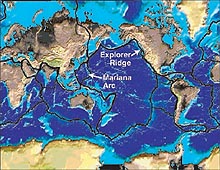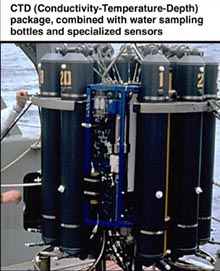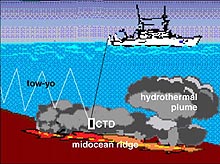|
|
 |
 |
|
|
This
illustration of a small segment of mid-ocean ridge crest shows the development
of hydrothermal plumes, which indicate the presence of vents. Click image
for larger view and more information.
|
|
|
Exploring for Hydrothermal Systems in the Deep Ocean
Dr. Edward T. Baker
Supervisory Oceanographer
NOAA, Pacific Marine Environmental Laboratory
Oases on the Seafloor
Scattered
along the barren ocean floor lie uncounted oases of hot, chemical-rich springs.
Fluids from these springs construct mineral deposits and nurture unique biological
communities. They alter deep-sea circulation patterns and profoundly influence
ocean chemistry and biology. They account for about 10 percent of the heat
loss from the entire solid earth. Even 25 years after their discovery, we
know far less about their distribution on the seafloor than about the distribution
of craters on the far side of the moon.
Seafloor
hydrothermal sites are a submarine version of Yellowstone National Park.
Cold seawater in deep cracks is heated by cooling magma, becomes buoyant,
and rises to the seafloor. Instead of forming a warm pond, as at Yellowstone,
the hot fluid rises like a hot-air balloon into the cold ocean, cooling as
it mixes with the cold seawater. Mixing continuously dilutes the hot discharge
and increases its volume as it rises, until the hydrothermal plume achieves
neutral buoyancy and is dispersed by the local currents. This hydrothermal
circulation pattern occurs wherever seafloor cracks can channel seawater
to layers of hot rock.
The Submarine Ring of Fire
Conditions
favorable for hydrothermal venting predominantly occur in two deep-ocean
environments where magma rises to form new crust: mid-ocean ridges and island
arc volcanoes. Mid-ocean ridges are linear features winding some 60,000 km
across the ocean floor wherever two of the Earth’s tectonic plates diverge.
Island arc volcanoes are point sources of magma delivered to the ocean floor
by mantle melting occuring along the 22,000 km of oceanic subduction zone
where two plates converge. At ridges, the ocean crust is created, while at
island arcs, it returns to the Earth’s mantle. These two environments form
the “Submarine Ring of Fire,” surrounding the Pacific Ocean.
 |
|
|
On
this map of the Earth’s surface, the plate boundaries are marked by a heavy
black line. The boundary on the east side of the Pacific is a divergent boundary
where the Pacific Ocean is being formed. Meanwhile, the boundary on the west
side of the Pacific is primarily convergent, where the Pacific Ocean crust
is subducted beneath more westerly plates and returns to melt within the
mantle. Click image for larger view and more information.
|
|
|
The Explorer’s Toolkit
Exploring
for hydrothermal systems requires a basic set of tools and appropriate search
strategies. The explorer’s toolkit includes detailed maps of the seafloor,
instruments to detect plumes, and vehicles to search the seafloor. Search
strategies vary according to the environment under investigation.
No
search can begin without detailed bathymetric maps that precisely define
the shape of the seafloor. Seafloor bathymetry provides a roadmap that greatly
narrows the search areas and identifies seafloor areas conducive to the development
of vent fields. Mid-ocean ridges are continuous linear features, and hydrothermal
fields may occur virtually anywhere along their path. Venting on island arc
volcanoes occurs mostly at their summits, which are typically separated by
tens of kilometers along the arc.
While
seafloor hydrothermal sites on ridges and arcs are likely numerous, the active
discharge orifices themselves are small, scattered, and difficult to find.
The chance of success can be greatly increased by searching first for the
tell-tale plumes the vents emit, and not the vents themselves. As a trail
of wind-blown smoke draws the eye to a smokestack, oceanographers use maps
of hydrothermal plume tracers that lead back towards a field of vents. The
tracers can be physical measurements such as changes in temperature, salinity,
and optical characteristics of the water. Chemical characteristics of the
plume are also used, including various trace metals and gases common in a
hydrothermal discharge.
Finding a Small Plume in a Big Ocean
These
tracers are mapped both by real-time measurements in the plume itself and
by collecting water samples for later analysis. The basic tool, used by oceanographers
around the world, consists of a Conductivity-Temperature-Depth (CTD) package
combined with sampling bottles that can be closed on demand. Added to this
are specialized sensors that can detect specific hydrothermal tracers. The
package can be lowered vertically to the seafloor while the research ship
holds position, gathering data and collecting samples throughout the water
column. A more effective strategy for plume hunting is a “tow-yo,” where
the instrument package is continually raised and lowered within the bottom
few hundred meters of the water column while the ship steams slowly ahead
at a speed of about 1.5 kt. This allows investigators to more precisely determine
the shape of a hydrothermal plume and thus the location of its source on
the seafloor.
|
|
|
 |
|
|
Top: A closeup of the primary tool used to map hydrothermal plumes. A ring
of plastic sampling bottles surrounds the CTD. The bottles are closed on
command from the ship, usually when a scientist monitoring the sensors sees
strong evidence of a plume. The blue frame holds a unique PMEL-developed
in-situ chemical analyzer, capable of real-time chemical analyses
of iron, manganese, and other plume tracers. Left: Scientists deploy the
CTD. Click image for larger view.
|
|
|
Once
the plume studies have detected active venting and localized its location,
it is the job of specialized seafloor exploration tools to find the actual
vents and associated biological communities. Such tools include Remotely
Operated Vehicles (ROVs), Autonomous Underwater Vehicles (AUVs), and occupied
submersibles (such as Alvin). These vehicles are used to create detailed
maps of the vent fields and collect biological, geological, and chemical
samples from the seafloor itself. The capabilities and use of these devices
are explained in ROVs and AUVs.
 |
|
|
An
illustration of a CTD “tow-yo” survey, which creates two-dimensional images
of hydrothermal plumes. Click image for larger view and more information.
|
|
|
Exploring the Ocean, Expanding Our Knowledge
Hydrothermal
venting can develop on only a minuscule portion of the seafloor, yet its
effects influence the entire ocean and support a unique biological community
that may be Earth’s earliest ecological niche. While we understand many of
the basic principles that govern this phenomenon, we remain deeply in the
explorative stage of this research. We are surprised almost daily by discoveries
of vents where we expected none, chemical compositions that were unpredicted,
and the cataloging of new biological species. The ocean is a harsh and unyielding
environment, and new progress is hard won. But the excitement and value of
increasing our knowledge of one of Earth’s basic processes makes this exploration
among the most rewarding we can imagine.
(top)
|